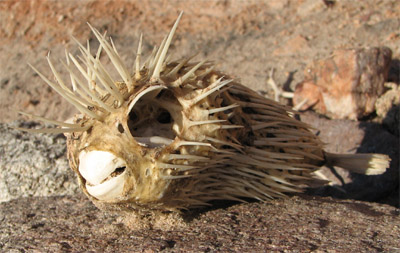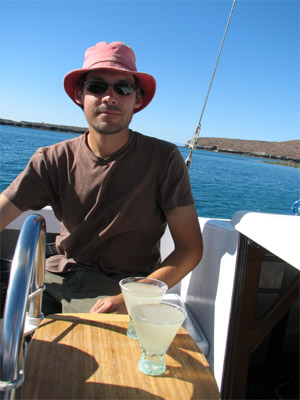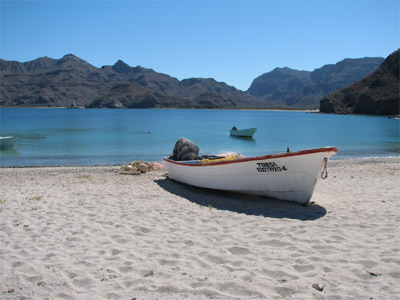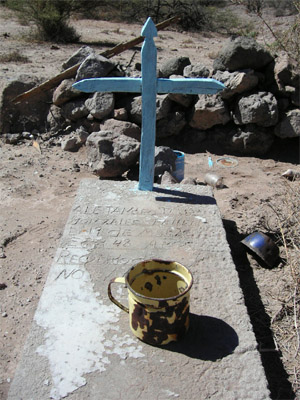Up to Bahia Agua Verde
February 8th, 2006 by: cheyenne
(Johnny Rotten Pufferfish. San Jose Island.)
We left La Paz on a day with mild wind but coming from north-northeast so we were able to tack surprisingly few times to get out of the narrow La Paz channel. We ejected out into the wide yonder and put out the fishing gear. And caught, no, not a dorado (damn!) but a pelican (stupid pelican). We were going rather fast when it happened and the poor thing was immediately pulled under the water and upside down and spinning and flailing and it was not in the least bit funny that he looked so terribly goofy with his pelican legs sticking up in the air and wings all askew. All his pelican buddies were very interested in current events and were crowding and craning their necks vainly to see what massive fish he must have a hold of and if they could possibly snag it from him; they cleared out after we dropped the sails and began to pull him towards the boat. We couldn’t just cut him loose because we didn’t want to lose the lure. NO! I mean, we didn’t want him to accidentally swallow the hook; we’d have a boatload of guilt and the ghost of a pissed off pelican to contend with. We got him finally to the boat and Joshua promptly snatched his beak shut. Much flapping ensued initially but for the most part, the pelican held fairly still while we extracted the hook from his pouch using scary tools. Pelican thus freed, we stopped fishing and continued on to the anchorage at Lobo. We had steak and cocktails for dinner so we weren’t too torn up over the lack of fish.


The above is a photo of a shrimp boat that was anchored near us for the night.
The next day we headed up to Espiritu Santa, stopped for lunch and ended up anchoring off Ensenada Grande for the night. The day started out with minimal wind but in the afternoon we were sailing upwind in sustained 20-25 knots with gusts to 30. Coming into the anchorage, the gusts were vicious, water-flattening beasts and coming from all different directions (funneling down the arroyos and canyons of the island). We crept into the lee of a large bulbous hill and managed to get out of the wind somewhat.
We were awakened the next morning to a lot of obnoxious motion and the boom making a major racket; the wind had shifted to the south and was now blowing directly into the anchorage, which protects you from the north wind (excepting, of course, the errant freaky gust). We pulled anchor just before sunrise, put the coffee on, and headed on for Isla San Francisco (a south wind is abnormal for these parts but perfect for the direction we were headed so we were psyched to get to take advantage of the smooth sailing direction). We made it 19 of the 20 miles to SF in two and a half hours before the wind died; then it took us an additional 12 billion hours to actually make it into the anchorage. We ghosted in and dropped our anchor on the north side of the bay.
About mid way en route to San Francisco, we spotted a large section of major splashing in the ocean and, thinking it could be a huge school of dorado! or yellowfin!!, we altered course towards it. It was soon apparent that this altering was unnecessary because the splashing was headed rapidly for us and it was not dorado, dagnabit, but a humongous pod of dolphins. They were not fishing and soon they overtook the boat, parting in the middle to go around us, no interest in us whatsoever, then moved on.
Back in San Francisco anchorage, we went ashore and wandered the island for a bit; there are salt ponds in the middle of the flat and we took a little bit of it with us (I hope that was okay..). Yum! We also chatted with a couple on the beach (they sailed over in a small 27 footer and tent-camped on the beach) who said that one of the Mexican fishermen was just yanking fish from the water by the reef off the south edge of the bay. We decided to try this and kayaked over there just as the sun was setting, dropped a line and promptly caught a fish!! It was a cochita (triggerfish), which are weird looking things with very rough skin, a major dorsal spike, and some serious snaggle teeth. We tossed him in a bag so he wouldn’t gnaw through the kayak or Joshua’s foot and kayaked at top speed for the boat. Sadly, we did not know much about cochita anatomy, not to mention that his skin was tougher than the majority of sharp objects we carried on board, and so we (cough, Joshua) had a very difficult time killing and bleeding the guy. (Ack! Cochita ghosts!)
The meat was white, very firm—firmer than what you normally mean when you say a fish meat is firm (yet not tough), but good. We barbecued it for dinner on a bed of onions, garlic, and jalapeno slices (with olive oil and Isla San Francisco salt) and had the remainder for breakfast tacos the following morning. All the boats cleared out the next day and the wind had shifted to the north so we crossed the little bay in an attempt to keep out of the wind. And also to be closer to the hot fishing spot. Soon, more boats appeared and the first one anchored fairly close to us. Odd with all the space in the bay but whatever. Then another came in and anchored next to us again. At this point we figured that they must think we knew something they didn’t. I joked that the next boat would come in and anchor right in the middle of the three boats and sure enough, a medium-sized sailboat, K—-t, came motoring in and dropped their anchor nearly on our poop deck! We were annoyed by this one because as soon as the anchor was set, we had to listen to them having cocktails, probably refrigerated ones with ice, and snack hour in their cockpit; I mean, they were RIGHT THERE!!!

We took off the next morning, headed around the island and anchored off the north shore to go ashore and wander around (a nice anchorage in sand but not really protected). Then we went across to San Jose Island and anchored finally (after much puttering around looking for a good spot) off the southern beach. We kayaked to the island and into the lagoon and explored the mangrove estuary. San Jose is a huge island that looked really interesting but the anchorage is dicey and not protected very well if there was any non-northerly weather so we didn’t go too far. We took off the next morning for, tentatively, Napolo, a small village and somewhat sheltered anchorage about 15 miles to the north. The wind was very good, although coming directly from the direction we wanted to go (thus forcing us to tack back and forth and traveling farther than the direct route). Amusingly, we heard another boat call K—-t on the radio apologizing for anchoring sort of close; we were thinking, “Hell, they don’t care!â€
We made good time to Evaristo and went on for Napolo, but it didn’t look all that protected so we decided to head on to the next anchorage in Los Gatos, another 20 miles north, because we had some bitchin’ wind. Naturally, the wind died completely only a third or so of the way. We turned on the motor and began motoring in order to reach Gatos before sunset. This was fine, although irritating and noisy but after a bit, the swell came up and turned into 4-6 feet of tight chop. Our motor doesn’t do so well in these conditions and the last two hours into Gatos took nearly forever with me gnashing my teeth and wringing my hands every time the outboard pulled out of the water. The approach to Gatos was made all the more interesting by, not only Charlie’s Chart NOT BEING ACCURATE in a big way, but big ol’ reefs all over the place with massive breaking waves (because of the big swell), the sun just about to set behind the land and all the defining features of the anchorage (black rock, red cliffs, yellow dunes, white house, etc.) being more like gray rock, gray cliffs, gray dunes, gray house, etc. We were about to turn back and anchor off the beach of Bahia San Carlos where we’d hopefully be out of the swell when we finally spotted masts of another boat anchored inside Gatos. We came blasting in and out of the chop and made it to anchor without any disasters. Then I wrote some tight comments into our Charlie’s Charts about the inaccuracy of his “maps†and that made me feel a little better. The more current edition has correct “maps,†by the way.
It turns out that Los Gatos is really a very pretty anchorage: there are red cliffs and Grand Canyon-esque scenery (the dunes are not exactly yellow though). We chatted with a swiss couple for a bit about multi-hulls versus monohulls, curious customs procedure in foreign countries, and metric versus imperial (a topic endlessly fascinating and confounding to people who grew up using metric). Most Europeans are flabbergasted to discover that we know what a meter even is. The next morning we chatted with Manuel, a local fisherman from the village at Timbabichi and he said that fishing was poor at this time in the Sea; it will pick up in March but in the off season, don’t expect to catch more than the random fish here and there. He was amused by our setup: a purple line of 50 meters or so with a rusty bell on the boat end and a clasp on the fish end for the lure, all this wrapped around an hourglass-shaped, worm-holey piece of board we picked up on a beach in San Quentin. Funny, he was not the first (or last) Mexican fisherman to take specific note of our fishing setup. I guess most of the American tourists he encounters have fancier fishing rigs than us.


(Frolicking pelicans!)
We got another south breeze and took advantage again to head north for Bahia Agua Verde, touted as one of the most popular anchorages in the Sea in Stupid Charlie’s Charts. A few minutes after we left Gatos, our traveler ejected a bit of plastic off the end and started coughing up ball bearings. Joshua scrambled to collect what he could but we had to jury-rig some sort of boom preventer/haul-down/something-something. I think I like the jury-rigged setup better than the damned traveler-track setup; it’s more secure and doesn’t make as much noise below. I’m thinking we’ll keep it this way and figure out how to make it look more ‘permanent.’
Bahia Agua Verde is really lovely with little anchoring nooks on the north and south; we chose the south due to the southern swell. There is a small village (approximately 200 inhabitants) of houses scattered among cactus, palm and palo verde trees. Amongst the houses and trees roam a staggering, albeit sparse, variety of livestock (excepting goats): goats (lots), cows, burros, pigs, chickens, turkeys (including a white one!), and goats—including baby goats, which are supercute. Goat poop is also worth a mention: there is a lot of goat poop in them thar hills. Houses have funky fences around them for the most part (this has something to do with the goats, I bet) and because water seems to be relatively plentiful, the houses are decorated with interesting cactus gardens and bougainvillea bushes.


(Grave from the small graveyard at Agua Verde. Note freshly painted blue cross and freshly discarded blue paint bucket just behind the grave.)
Shortly after anchoring, a panga came out with a family aboard to bum pens/pencils and try to sell quaint handmade jewelry to the biggest fattest jewelry snob in the Sea of Cortez. I gave them some pens while Joshua grilled the fisherman on what sorts of fish were being caught these days in the sea. Not much right now because it’s the off-season; but they do net small sharks. (Sharks!) On one of our hikes, we discovered the shark butchering fields too—a scattered pile of shriveled up shark heads, including hammers; none very large. Another sailor we spoke with said that the “off-season†is not just “February†anymore; the sea is becoming rapidly fished-out and every year they catch fewer and fewer fish.
Sam and Christy on the boat ‘Livin’ arrived the same day as us and we spent a couple of evenings chatting with them and collectively put away a wide variety of booze and snacks. We ended up buying a short wave/SSB receiver that they didn’t use so now we get to listen to the big wide world out there. The big wide world can be very staticy and has given me much insight as to where Lucas came up with all those droid ‘voices.’ The Imperial Probe Droid? Hosts the morning ‘Amigo Net’ on Mondays. Who knew?


February 20th, 2006 at 11:08 am
Hey kiddos,
Great reading! Sounds idyllic and sunny and peaceful. I met a guy at an “Author’s Book Sale” in Patagonia, AZ., the other day, and he has written several books with maps and where to anchor and tips, etc. about Baja and the Sea of Cortez. Maybe you have one of his books—they are kind of big paperback things with lots of maps and photos and boating info. Maybe he is “Charley”? Anyway, he claims he is the definitive author of books about the region.
Things are fine here at the rancho. My friend, Jan Leonard, from SF, will be in Zihuatanejo March 5-15, in a little casita on the beach. If you are in the area, I’ll give you more info as to where she is staying. She’d love to see you and check out your boat.
Keep us posted as to your adventures. Love, Mom/Peg